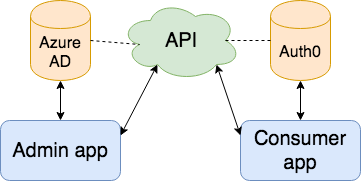Accept tokens from multiple identity providers in .NET Core
There’s at least 2 ways of interpreting the title of this post, it could mean:
- As an API, accept tokens coming from multiple applications that use different identity providers.
- As an application, allow a user to sign in using multiple 3rd party identity providers, and optionally act as an identity provider yourself by issuing your own tokens.
This post is mainly concerned with the first alternative.
Motivation
What’s the point of doing this then? Well in our case it’s that the main application the API was built to serve (an administration application) authenticates against the organizations AAD (Azure AD). The application that will now be granted access to the API is however a customer facing application which authenticates the user against Auth0, and it’s not currently in scope to change the admin application to authenticate against Auth0 for business reasons.
Illustration of what we’re trying to accomplish

The code
All the code that we need to change (to get this to work, if you have any custom authorization then you might need to change that as well) is in the public void ConfigureServices(IServiceCollection services) method of our Startup.cs file.
Before we start adding the new idp (identity provider, Auth0 in this case) our ConfigureServices look something like this:
public void ConfigureServices(IServiceCollection services)
{
// Here we add the bare minimum for validating tokens against our Azure AD.
// The application would retrieve a token from Azure AD (in our app, through the implicit flow)
// with the resource parameter set to the application id for the registration of this API in Azure AD.
// (the same id specified in validaudiences), this will set the aud claim of the token to the correct id,
// which is what the "AddJwtBearer" middleware will check against.
services
.AddAuthentication(JwtBearerDefaults.AuthenticationScheme)
.AddJwtBearer(o =>
{
//Identify the identity provider
o.Authority = "https://login.microsoftonline.com/{The tenant/directory id of your Azure AD}";
// We use this for retrieving more data about the user.
// But this is optional depending on your use case.
o.SaveToken = true;
o.TokenValidationParameters = new TokenValidationParameters
{
//Both the client id and app id URI of this API should be valid audiences
ValidAudiences = new List<string> { "{The applicationid of your api registration in Azure AD}" }
};
});
services.AddAuthorization(options =>
{
// You might add this as a default policy but we're using this as a base for other policies as well.
var apiPolicy = new AuthorizationPolicyBuilder()
.RequireAuthenticatedUser()
.Build();
options.AddPolicy("Api", apiPolicy);
});
}With this code we have an API that will accept tokens from AAD with the aud claim set to the application id for the API when registered in AAD (it’s up to the calling application to specify that the requested token is for this API).
Now we will need to make some small changes to be able to accept either a AAD OR Auth0 token.
public void ConfigureServices(IServiceCollection services)
{
services
.AddAuthentication("aad")
.AddJwtBearer("aad", o =>
{
//Identify the identity provider
o.Authority = "https://login.microsoftonline.com/{The tenant/directory id of your Azure AD}";
// We use this for retrieving more data about the user.
// But this is optional depending on your use case.
o.SaveToken = true;
o.TokenValidationParameters = new TokenValidationParameters
{
//Both the client id and app id URI of this API should be valid audiences
ValidAudiences = new List<string> { "{The applicationid of your api registration in Azure AD}" }
};
})
.AddJwtBearer("auth0", o =>
{
//Identify the identity provider
o.Authority = "https://{the tenant id of your Auth0 tenant}.eu.auth0.com";
// We use this for retrieving more data about the user.
// But this is optional depending on your use case.
o.SaveToken = true;
o.TokenValidationParameters = new TokenValidationParameters
{
//Both the client id and app id URI of this API should be valid audiences
ValidAudiences = new List<string> { "{The Audience of your Auth0 API registration}" }
};
});
services.AddAuthorization(options =>
{
// You might add this as a default policy but we're using this as a base for other policies as well.
var apiPolicy = new AuthorizationPolicyBuilder("aad", "auth0")
.AddAuthenticationSchemes("aad", "auth0")
.RequireAuthenticatedUser()
.Build();
options.AddPolicy("Api", apiPolicy);
});
}As you can see we’ve added another call to AddJwtBearer which as identical to the first call, except for the values of the properties. You might also see that we’ve used the named AddJwtBearer overload which is necessary to be able to use both of them, otherwise the last call would “win” and only that registration would actually be checked against. This also allows us to add different idps to different policies, for instance to only allow one idp to a admin endpoint but everyone to all the normal endpoints, but in our case we add both idps to our “Api” policy. It should be possible to add them to either the new AuthorizationPolicyBuilder constructor, or to the AddAuthenticationSchemes call, but I’ve only gotten it to work by adding it to both.
The last thing we do is to set our “default” idp name in the call to AddAuthentication.
Things you might need
If you have the need to somewhat normalize the user information from multiple idps, for instance if you use the User.Identity.Name in a controller, then you may use the OnTokenValidated event to controll how the idp token claims flow into your ClaimsIdentity.
.AddJwtBearer("auth0", o =>
{
...
o.Events = new JwtBearerEvents
{
OnTokenValidated = async ctx =>
{
// Mock call to Auth0 UserInfo endpoint to retrieve more information for the user
// then what's contained in the access_token (the userinfo endpoint serve the same info that an id_token contains)
var userInfo = await userInfoProvider.Get((JwtSecurityToken)ctx.SecurityToken);
((ClaimsIdentity)ctx.Principal.Identity).AddClaim(new Claim(ClaimTypes.Name, userInfo.Email));
}
};
})Resources used when finding this solution
- https://github.com/aspnet/Security/issues/1708#issuecomment-376567491
- https://github.com/aspnet/Security/issues/1664
- https://stackoverflow.com/questions/49694383/use-multiple-jwt-bearer-authentication
- https://joonasw.net/view/adding-custom-claims-aspnet-core-2
- https://github.com/aspnet/Security/issues/1310